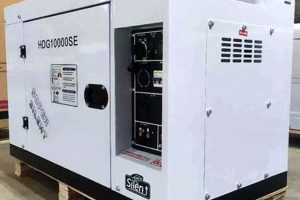Maintaining proper lubrication is essential for the longevity and performance of any combustion engine. For portable generators, this translates to regular oil changes. Typically, the initial oil change is recommended after the first 5-20 hours of operation, a break-in period crucial for seating new engine components. Subsequent oil changes depend on usage and operating conditions.
Consistent maintenance, including timely oil changes, prevents premature engine wear caused by friction and heat buildup. Fresh oil effectively lubricates moving parts, carries away debris, and helps regulate engine temperature, leading to improved efficiency and extended lifespan. Historically, neglecting this basic maintenance has been a primary cause of generator failure, a costly oversight easily avoided through adherence to manufacturer guidelines.
The following sections will delve into the specifics of oil change frequency based on generator usage, types of oil suitable for different engines, and step-by-step instructions on performing an oil change safely and efficiently.
Tips for Generator Oil Maintenance
Proper oil maintenance is crucial for ensuring the reliable operation and longevity of a portable generator. The following tips offer guidance on this essential aspect of generator care.
Tip 1: Consult the Owner’s Manual: Manufacturer recommendations supersede general guidelines. The owner’s manual provides specific oil change intervals based on the generator model and engine type.
Tip 2: Consider Operating Conditions: Frequent use in dusty or hot environments necessitates more frequent oil changes. Heavy loads also contribute to faster oil degradation.
Tip 3: Adhere to the Break-In Period: The initial oil change is critical. Changing the oil after the first 5-20 hours of operation removes metal shavings and debris generated during the break-in process.
Tip 4: Use the Correct Oil Type: Employ the oil viscosity recommended by the manufacturer. Using an incorrect oil grade can negatively impact engine performance and lifespan.
Tip 5: Check the Oil Level Regularly: Before each use, inspect the oil level using the dipstick. Low oil levels can lead to severe engine damage. Top up as needed.
Tip 6: Change the Oil While the Engine is Warm: Warm oil flows more freely, facilitating complete drainage. Exercise caution to avoid burns.
Tip 7: Dispose of Used Oil Responsibly: Used oil is an environmental hazard. Collect and dispose of it at designated recycling centers or collection points.
By following these guidelines, generator owners can significantly extend the lifespan of their equipment and ensure reliable performance when needed most.
This proactive approach to maintenance minimizes the risk of costly repairs and ensures the generator is ready to provide power during outages or emergencies.
1. Frequency
Oil change frequency is paramount for maintaining a portable generator’s operational integrity. Appropriate frequency prevents premature wear and ensures optimal performance. Several interconnected factors influence the ideal oil change schedule.
- Operating Hours:
Tracking operating hours provides a quantifiable measure of engine use. Generators running continuously for extended periods accumulate wear and tear faster, necessitating more frequent oil changes. For instance, a generator powering a construction site daily requires more frequent oil changes than one used for occasional backup power. Recording run time and adhering to manufacturer-recommended intervals based on these hours are essential.
- Load Conditions:
Operating a generator under heavy load, near its maximum power output, places greater stress on the engine components. This increased stress accelerates oil degradation. Generators consistently operating near maximum capacity require more frequent oil changes compared to those running lighter loads. Monitoring load levels and adjusting the oil change schedule accordingly is crucial for optimal engine health.
- Environmental Factors:
Operating environments significantly impact oil life. Dusty or excessively hot conditions introduce contaminants and accelerate oil breakdown. Generators used in such environments require shorter oil change intervals compared to those operating in cleaner, temperature-controlled conditions. Evaluating the operating environment is essential for determining appropriate oil change frequency.
- Manufacturer Recommendations:
Manufacturer guidelines offer tailored recommendations specific to the generator model and engine type. These recommendations consider factors such as engine design, oil capacity, and intended use case. Consulting the owner’s manual for specific oil change intervals is critical for maintaining warranty coverage and ensuring optimal generator performance and longevity.
These factors collectively influence the optimal oil change frequency. Balancing these elements and adhering to a proactive maintenance schedule ensures a portable generator remains reliable and efficient throughout its operational life.
2. Operating Hours
Operating hours serve as a critical metric in determining oil change frequency for portable generators. This direct correlation stems from the fact that engine wear and oil degradation occur cumulatively with usage. Every hour of operation contributes to the breakdown of the oil’s lubricating properties and the accumulation of contaminants. Consequently, generators with higher operating hours necessitate more frequent oil changes to maintain optimal engine health. For example, a generator used for continuous power supply during a multi-day outage will require an oil change sooner than a generator used only for occasional short-term backup power. Conversely, a generator used sparingly might reach a time-based oil change interval before accumulating enough operating hours to warrant a change. This highlights the importance of tracking operating hours diligently.
The practical significance of understanding this connection lies in preventing premature engine wear and ensuring efficient generator performance. Regular oil changes based on operating hours remove accumulated contaminants and replenish the oil’s lubricating properties, minimizing friction and heat buildup within the engine. This proactive approach extends the generator’s lifespan and ensures reliable power delivery when needed. Neglecting to change oil based on operating hours can lead to increased engine wear, reduced fuel efficiency, and ultimately, costly repairs or even engine failure.
Tracking operating hours provides a tangible and quantifiable basis for scheduling oil changes, moving beyond arbitrary time intervals. This data-driven approach ensures maintenance aligns with actual engine usage, optimizing both generator performance and longevity. Challenges arise when accurate operating hour records are unavailable, particularly with used generators. In such cases, a thorough inspection by a qualified technician is recommended to assess engine condition and establish a suitable oil change schedule. Ultimately, prioritizing operating hours as a key determinant of oil change frequency is essential for responsible generator ownership and maximizing the return on investment.
3. Oil Type
Oil type significantly influences oil change frequency in portable generators. Different oil formulations offer varying levels of viscosity, additive packages, and resistance to degradation. These characteristics directly impact how effectively the oil lubricates engine components, manages heat, and withstands the stresses of operation. Conventional mineral oils tend to break down faster than synthetic oils, requiring more frequent changes. Synthetic oils, engineered for enhanced performance and longevity, offer extended drain intervals, although they often come at a higher initial cost. The operating environment also plays a role; extreme temperatures or dusty conditions necessitate oils with specific formulations designed for these challenges, sometimes requiring more frequent changes regardless of oil type. Selecting an oil type unsuitable for the engine or operating conditions can negate any potential benefits of extended drain intervals and may even lead to accelerated engine wear.
For instance, using a lightweight, low-viscosity oil in a high-temperature environment can result in inadequate lubrication, increasing friction and heat buildup. Conversely, using a heavy, high-viscosity oil in cold weather can hinder engine startup and proper oil flow. Matching the oil type to the manufacturer’s recommendations and the specific operating conditions is paramount for ensuring optimal engine performance and longevity. Real-world examples abound where incorrect oil type selection has led to premature engine failure, highlighting the practical significance of this understanding. A construction site generator operating in dusty conditions requires a different oil formulation than a backup generator in a climate-controlled environment, even if both are powered by similar engines.
In summary, oil type is not merely a consumable choice but a critical factor influencing generator maintenance schedules and overall engine health. Understanding the interplay between oil type, operating conditions, and engine requirements enables informed decisions that optimize generator performance and longevity. While cost considerations might influence oil selection, prioritizing the correct oil for the specific application ultimately minimizes long-term maintenance expenses and prevents costly engine damage. Ignoring this critical aspect can lead to significant operational challenges and compromise the reliability of the generator when needed most.
4. Engine type
Engine type directly influences oil change frequency in portable generators. Different engine designs, such as two-stroke and four-stroke engines, possess distinct lubrication requirements. Two-stroke engines, often found in smaller, less powerful generators, typically mix oil directly with the fuel, necessitating more frequent oil replenishment as it burns along with the gasoline. Four-stroke engines, common in larger generators, utilize a separate oil reservoir, allowing for longer intervals between oil changes. Furthermore, variations within four-stroke engine designs, including overhead valve (OHV) and overhead cam (OHC) configurations, impact oil flow and heat generation, influencing oil change schedules. An OHV engine, for instance, may operate at higher temperatures than an OHC engine of similar displacement, potentially requiring more frequent oil changes to prevent oil breakdown. Choosing the correct oil type and change frequency based on engine type is crucial for maintaining engine health and performance. Using an incorrect oil or neglecting timely changes can lead to accelerated wear, reduced efficiency, and potential engine failure.
Real-world scenarios illustrate the practical implications of this connection. A two-stroke generator used for camping trips requires frequent oil replenishment with each fuel refill, whereas a four-stroke generator providing backup power for a home might require an oil change only every 50-100 operating hours. Similarly, a commercial-grade generator with a high-performance four-stroke engine under heavy load might require more frequent oil changes than a residential unit used intermittently for light loads. Understanding these nuances is vital for ensuring appropriate maintenance practices. Ignoring the specific requirements of the engine type can lead to costly repairs and compromise the generator’s reliability when needed most.
In summary, engine type is a fundamental factor in determining the appropriate oil change frequency for portable generators. Recognizing the distinct lubrication requirements of different engine designs, including two-stroke, four-stroke OHV, and four-stroke OHC, empowers owners to implement effective maintenance strategies. This knowledge, coupled with adherence to manufacturer guidelines and consideration of operating conditions, ensures optimal generator performance and longevity. Failure to account for engine-specific requirements compromises not only the generator’s lifespan but also its ability to deliver reliable power during critical situations.
5. Load Conditions
Load conditions represent a crucial factor influencing oil change frequency in portable generators. The intensity and duration of the load placed on a generator directly impact the engine’s operating temperature and the rate at which the oil degrades. Higher loads generate more heat and stress within the engine, accelerating oil breakdown and necessitating more frequent changes. Understanding the relationship between load conditions and oil change intervals is essential for maintaining optimal generator performance and longevity.
- Continuous Heavy Load:
Operating a generator continuously under heavy load, near its maximum power output, subjects the engine to sustained stress and elevated temperatures. This sustained operation accelerates oil oxidation and thermal breakdown, requiring more frequent oil changes compared to intermittent or light-load operation. Examples include powering construction equipment or providing primary power during extended outages. The implication is a shortened oil change interval to maintain adequate lubrication and prevent premature engine wear.
- Intermittent Light Load:
Generators operating intermittently under light loads experience less stress and lower operating temperatures. This gentler operation reduces the rate of oil degradation, allowing for longer intervals between oil changes. Examples include occasional backup power for home appliances or powering small electronics during camping trips. The implication is a longer oil change interval compared to heavy-load operation, although regular monitoring remains essential.
- Fluctuating Load:
Generators subjected to fluctuating loads, transitioning between heavy and light demands, present a unique challenge. The varying stress levels and temperature fluctuations can accelerate oil degradation in unpredictable ways. Examples include powering tools with intermittent high-power demands or supporting a variable load during an event. The implication is a need for more vigilant monitoring of oil condition and potentially shorter oil change intervals based on the observed load patterns and engine performance.
- Overload Conditions:
Operating a generator beyond its rated capacity places extreme stress on the engine and dramatically accelerates oil breakdown. Overloading generates excessive heat, potentially leading to rapid oil oxidation and loss of lubricating properties. This scenario necessitates immediate attention and often requires an oil change after the overload condition, even if a recent change has been performed. The implication is a heightened risk of engine damage and the need for proactive load management to prevent overloading.
In conclusion, load conditions significantly impact oil degradation rates and, consequently, the required oil change frequency. Matching the oil change schedule to the prevailing load conditions ensures optimal engine lubrication and minimizes wear. Neglecting this crucial aspect compromises engine health, reduces efficiency, and shortens the generator’s operational lifespan. A proactive approach to monitoring load and adjusting maintenance schedules accordingly ensures reliable power delivery and maximizes the generator’s long-term value.
6. Environmental Factors
Environmental factors play a significant role in determining oil change frequency for portable generators. These factors influence the rate at which the engine oil degrades, impacting its ability to lubricate effectively and protect engine components. Understanding the interplay between environmental conditions and oil life is crucial for establishing appropriate maintenance schedules.
- Temperature Extremes
High ambient temperatures accelerate oil oxidation, reducing its viscosity and lubricating properties. Prolonged exposure to extreme heat can lead to premature oil breakdown, necessitating more frequent changes. Conversely, extremely cold temperatures can thicken the oil, hindering its flow and potentially causing damage during startup. Generators operating in extreme temperature environments require careful oil selection and potentially shorter change intervals.
- Dust and Debris
Operating a generator in dusty or dirty environments introduces airborne contaminants into the engine. These contaminants, including dust, dirt, and pollen, mix with the oil, forming abrasive particles that accelerate engine wear. Increased contaminant levels necessitate more frequent oil changes to remove these abrasive particles and maintain engine health. Generators used in construction sites, agricultural settings, or other dusty environments require particular attention to air filter maintenance and more frequent oil changes.
- Humidity and Moisture
High humidity levels can introduce moisture into the engine oil, leading to corrosion and reduced lubrication effectiveness. Moisture contamination can also promote the growth of microorganisms within the oil, further degrading its quality. Generators operated in humid coastal regions or areas with frequent rainfall require careful monitoring for moisture contamination and potentially more frequent oil changes.
- Altitude
Operating a generator at high altitudes, where the air is thinner, can impact engine combustion and operating temperatures. These altered conditions can influence oil life and require adjustments to the oil change schedule. Consulting the manufacturer’s recommendations for high-altitude operation is essential for maintaining proper lubrication and engine performance.
In conclusion, environmental factors exert a significant influence on oil degradation and, consequently, the required oil change frequency. Recognizing and mitigating the impact of temperature extremes, dust, humidity, and altitude is crucial for maintaining optimal generator performance and longevity. Ignoring these environmental influences can lead to accelerated engine wear, reduced efficiency, and premature generator failure. A proactive approach to monitoring environmental conditions and adjusting maintenance schedules accordingly ensures reliable power delivery and maximizes the generator’s operational lifespan.
7. Manufacturer Recommendations
Manufacturer recommendations provide the definitive guide for oil change frequency in portable generators. These recommendations, derived from extensive engineering and testing, consider the specific design, operating parameters, and intended use cases of each generator model. Adhering to these guidelines is paramount for maintaining optimal engine health, ensuring peak performance, and upholding warranty coverage. Ignoring manufacturer recommendations can lead to premature wear, reduced efficiency, and potentially voiding the warranty.
- Owner’s Manual Specificity
The owner’s manual serves as the primary source of manufacturer recommendations. This document provides precise oil change intervals based on operating hours, load conditions, and environmental factors specific to the generator model. Real-world examples include specifying an initial oil change after the first 5-20 hours of operation, followed by subsequent changes every 50-100 hours under normal operating conditions. The implication is that deviating from these specific guidelines can compromise engine longevity and performance.
- Oil Type and Viscosity
Manufacturers specify the recommended oil type and viscosity for each generator model. These recommendations consider factors such as engine design, operating temperature ranges, and load capacities. Using an incorrect oil viscosity can lead to inadequate lubrication at high temperatures or excessive resistance at low temperatures, potentially causing engine damage. The practical implication is the need to adhere strictly to the specified oil type and viscosity for optimal engine protection.
- Severe Service Intervals
Manufacturers often provide “severe service” oil change intervals for generators operating under demanding conditions, such as continuous heavy loads, dusty environments, or extreme temperatures. These shortened intervals recognize the accelerated oil degradation under such conditions. Ignoring these severe service recommendations can drastically reduce engine life. Real-world examples include reducing the oil change interval to 25 hours for generators operating continuously in extremely dusty environments. The implication is that assessing operating conditions and adjusting maintenance accordingly is crucial for long-term reliability.
- Warranty Compliance
Adhering to manufacturer-recommended maintenance schedules, including oil changes, is often a prerequisite for maintaining warranty coverage. Failure to document adherence to these schedules can void the warranty, leaving owners responsible for potentially costly repairs. The practical implication is that meticulous record-keeping of oil changes and other maintenance tasks is essential for protecting the investment and ensuring warranty validity.
In conclusion, manufacturer recommendations represent the cornerstone of effective oil maintenance for portable generators. These guidelines, tailored to each specific model, provide critical information regarding oil type, viscosity, change intervals, and severe service adjustments. Adhering to these recommendations ensures optimal engine performance, maximizes longevity, and maintains warranty validity. Ignoring manufacturer guidelines compromises engine health, potentially leading to costly repairs and premature generator failure. Prioritizing these recommendations demonstrates a commitment to responsible generator ownership and ensures reliable power delivery when needed most.
Frequently Asked Questions
This section addresses common inquiries regarding oil changes for portable generators, providing concise and informative responses to clarify potential uncertainties and promote best practices.
Question 1: What happens if oil changes are neglected?
Neglecting oil changes leads to accelerated engine wear due to increased friction and heat buildup. Oil degradation reduces its lubricating properties, compromising engine component protection and potentially leading to premature failure.
Question 2: Can any type of oil be used in a portable generator?
Using an incorrect oil viscosity can negatively impact engine performance and longevity. Always adhere to the manufacturer’s recommended oil type and viscosity for optimal results.
Question 3: How is oil checked in a portable generator?
Oil levels are typically checked using a dipstick. Ensure the generator is on a level surface, and consult the owner’s manual for specific instructions on locating and interpreting the dipstick readings.
Question 4: Is it necessary to change the oil filter with every oil change?
While not always mandatory, changing the oil filter with each oil change is generally recommended. The filter traps contaminants, and replacing it ensures optimal oil filtration and engine protection. Consult the owner’s manual for specific guidance.
Question 5: What are the signs of needing an oil change?
Dark, gritty oil or a persistent burning smell can indicate the need for an oil change. Regularly checking oil levels and adhering to recommended change intervals are essential preventative measures.
Question 6: Where should used generator oil be disposed of?
Used oil should never be poured down drains or disposed of in regular trash. It poses an environmental hazard and should be collected and taken to designated oil recycling centers or collection points for proper disposal.
Regular maintenance, including timely oil changes, safeguards the generator’s performance and lifespan. Consulting the owner’s manual and adhering to manufacturer guidelines ensures optimal operation and prevents costly repairs.
The subsequent section delves into the practical aspects of performing an oil change on a portable generator, providing step-by-step instructions for a safe and efficient procedure.
Oil Change Frequency
Regular oil changes are essential for maintaining the performance and longevity of portable generators. This article explored the multifaceted factors influencing oil change frequency, including operating hours, load conditions, environmental factors, engine type, and manufacturer recommendations. Understanding the interplay of these elements enables informed decisions regarding maintenance schedules, optimizing generator reliability and lifespan. Adherence to manufacturer guidelines, coupled with proactive monitoring of operating conditions, ensures the generator receives appropriate maintenance, minimizing the risk of premature wear and costly repairs.
Ultimately, prioritizing timely and appropriate oil changes safeguards the investment represented by a portable generator, ensuring reliable power delivery when needed most. This proactive approach to maintenance translates to long-term cost savings and reinforces the generator’s role as a dependable power source in various applications.






